Essentials of Contract Law in Construction Management
VerifiedAdded on 2023/06/15
|15
|5544
|446
AI Summary
This article discusses the application of contract law in construction management, emphasizing the essentials required for a valid and legally enforceable contract. It also covers the duties, rights, and responsibilities of the parties involved, as well as provisions for dispute resolution and insurance. The article further explores the relocation of staff and equipment, staged access of the building, IT services, and safety measures in construction sites.
Contribute Materials
Your contribution can guide someone’s learning journey. Share your
documents today.
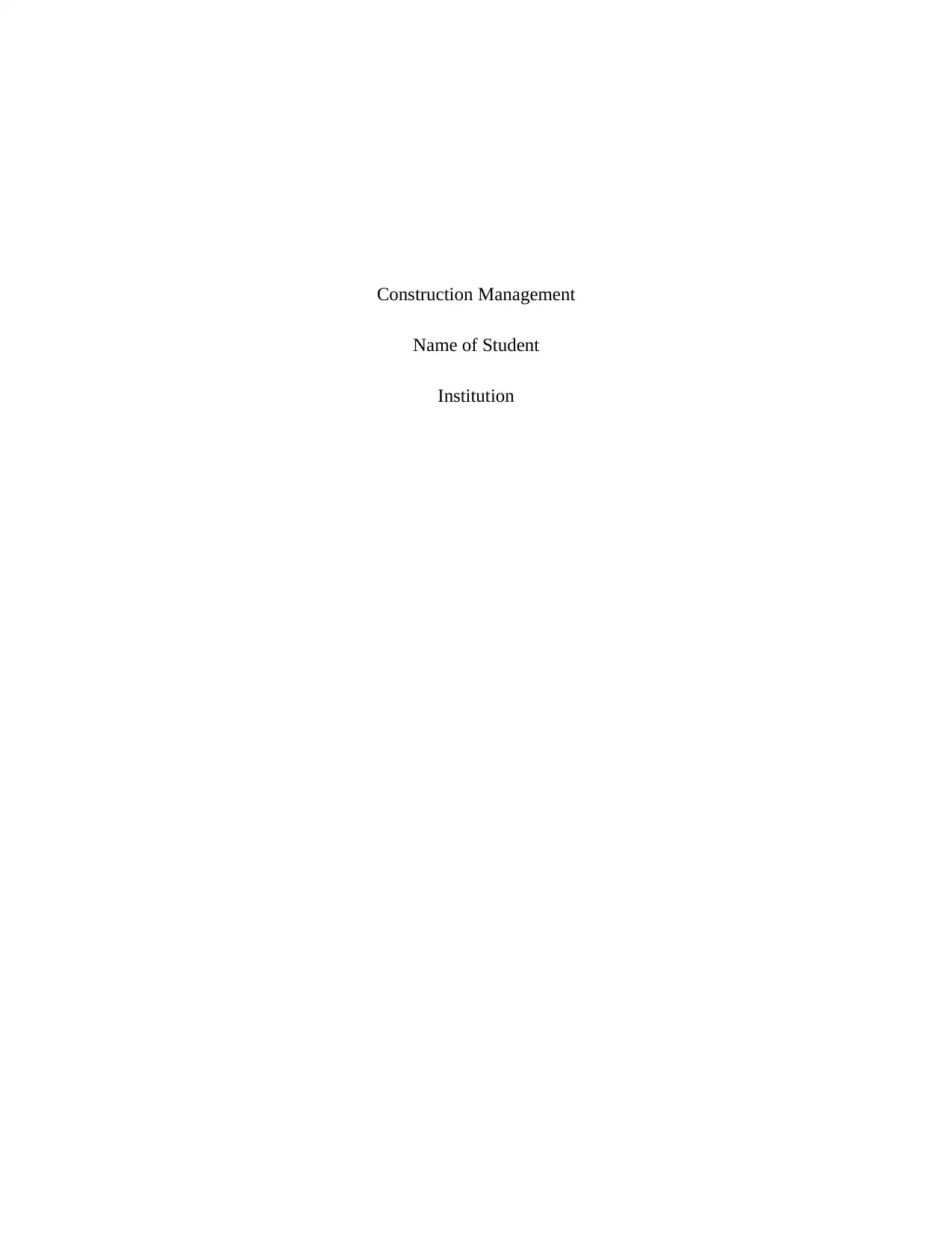
Construction Management
Name of Student
Institution
Name of Student
Institution
Secure Best Marks with AI Grader
Need help grading? Try our AI Grader for instant feedback on your assignments.
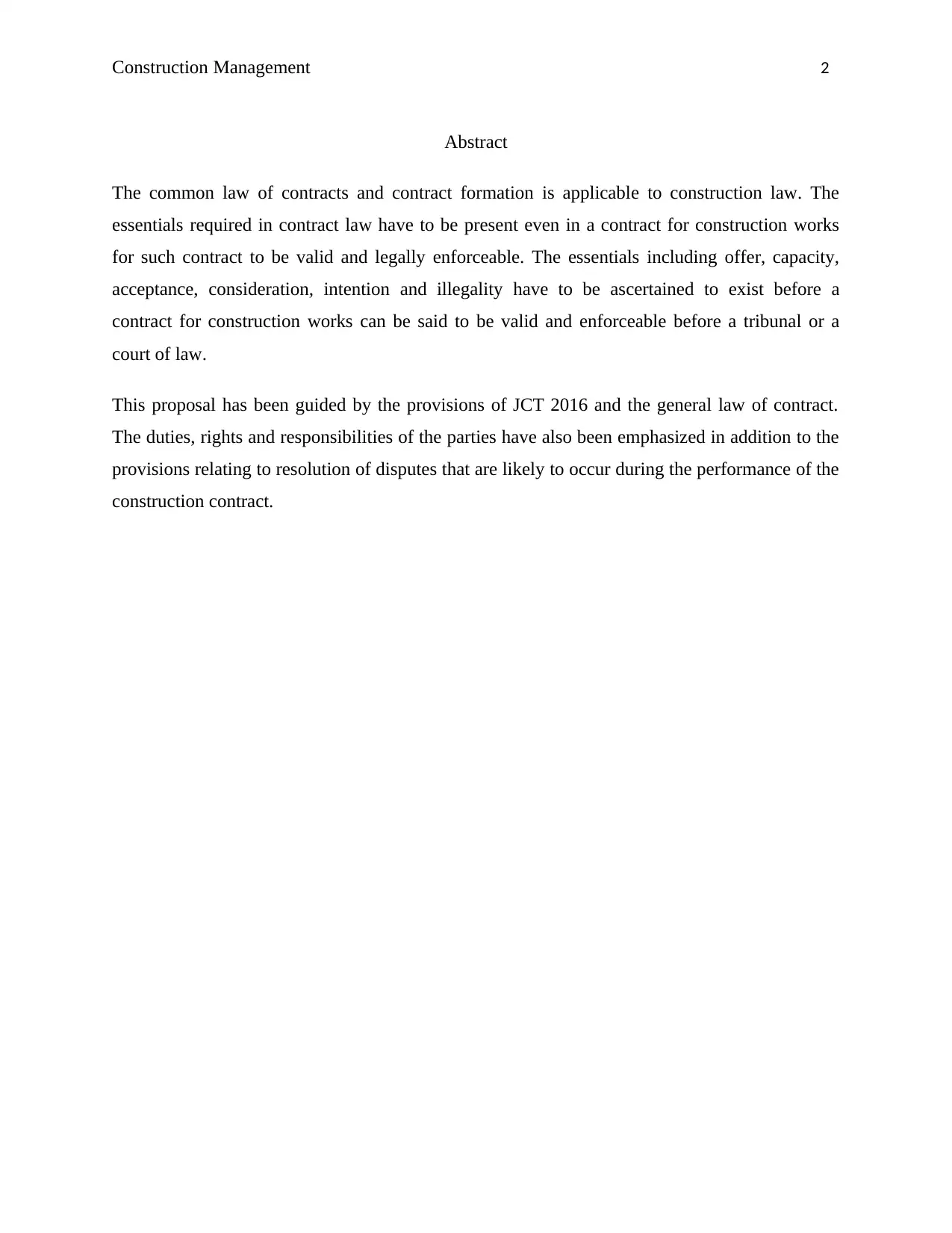
Construction Management 2
Abstract
The common law of contracts and contract formation is applicable to construction law. The
essentials required in contract law have to be present even in a contract for construction works
for such contract to be valid and legally enforceable. The essentials including offer, capacity,
acceptance, consideration, intention and illegality have to be ascertained to exist before a
contract for construction works can be said to be valid and enforceable before a tribunal or a
court of law.
This proposal has been guided by the provisions of JCT 2016 and the general law of contract.
The duties, rights and responsibilities of the parties have also been emphasized in addition to the
provisions relating to resolution of disputes that are likely to occur during the performance of the
construction contract.
Abstract
The common law of contracts and contract formation is applicable to construction law. The
essentials required in contract law have to be present even in a contract for construction works
for such contract to be valid and legally enforceable. The essentials including offer, capacity,
acceptance, consideration, intention and illegality have to be ascertained to exist before a
contract for construction works can be said to be valid and enforceable before a tribunal or a
court of law.
This proposal has been guided by the provisions of JCT 2016 and the general law of contract.
The duties, rights and responsibilities of the parties have also been emphasized in addition to the
provisions relating to resolution of disputes that are likely to occur during the performance of the
construction contract.
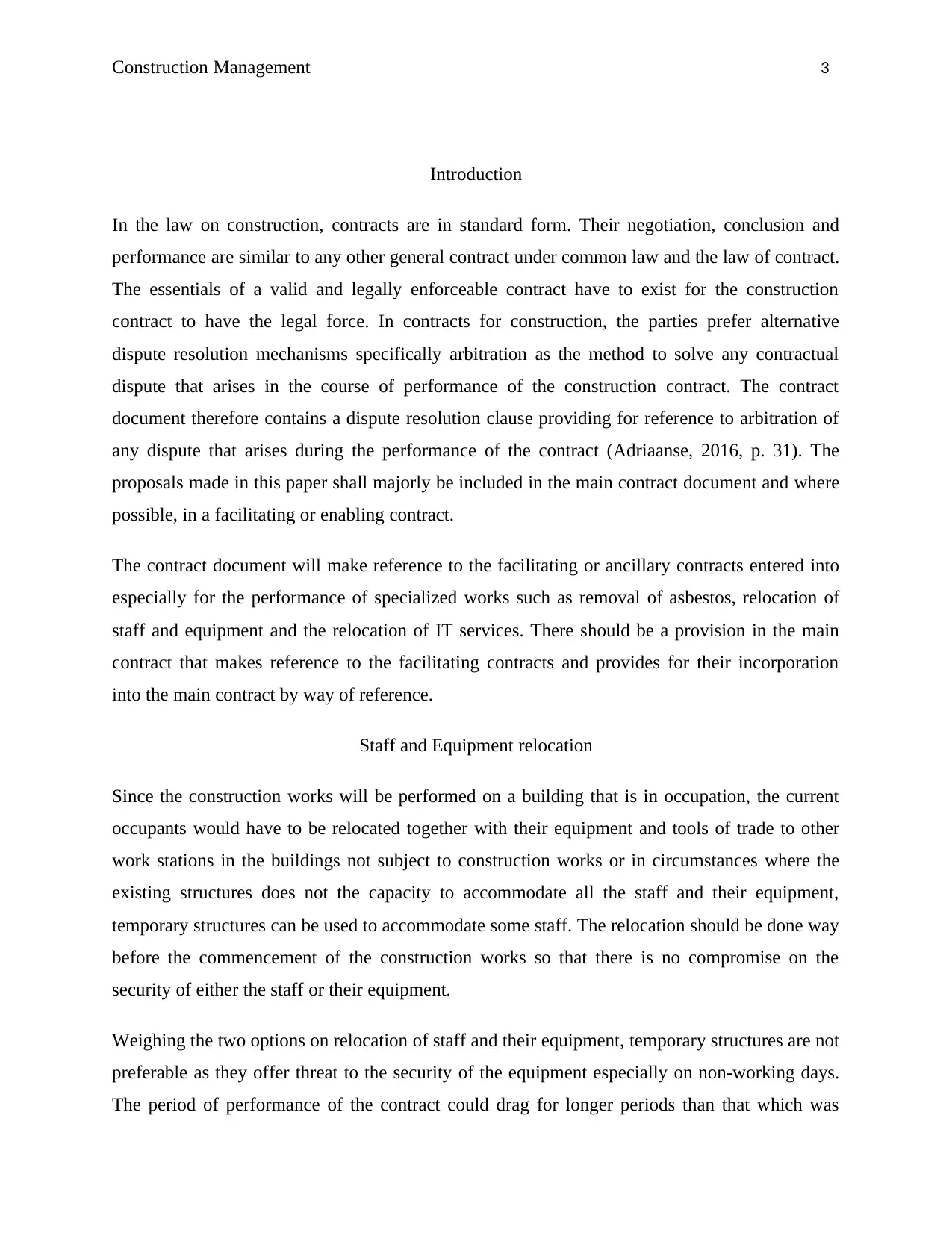
Construction Management 3
Introduction
In the law on construction, contracts are in standard form. Their negotiation, conclusion and
performance are similar to any other general contract under common law and the law of contract.
The essentials of a valid and legally enforceable contract have to exist for the construction
contract to have the legal force. In contracts for construction, the parties prefer alternative
dispute resolution mechanisms specifically arbitration as the method to solve any contractual
dispute that arises in the course of performance of the construction contract. The contract
document therefore contains a dispute resolution clause providing for reference to arbitration of
any dispute that arises during the performance of the contract (Adriaanse, 2016, p. 31). The
proposals made in this paper shall majorly be included in the main contract document and where
possible, in a facilitating or enabling contract.
The contract document will make reference to the facilitating or ancillary contracts entered into
especially for the performance of specialized works such as removal of asbestos, relocation of
staff and equipment and the relocation of IT services. There should be a provision in the main
contract that makes reference to the facilitating contracts and provides for their incorporation
into the main contract by way of reference.
Staff and Equipment relocation
Since the construction works will be performed on a building that is in occupation, the current
occupants would have to be relocated together with their equipment and tools of trade to other
work stations in the buildings not subject to construction works or in circumstances where the
existing structures does not the capacity to accommodate all the staff and their equipment,
temporary structures can be used to accommodate some staff. The relocation should be done way
before the commencement of the construction works so that there is no compromise on the
security of either the staff or their equipment.
Weighing the two options on relocation of staff and their equipment, temporary structures are not
preferable as they offer threat to the security of the equipment especially on non-working days.
The period of performance of the contract could drag for longer periods than that which was
Introduction
In the law on construction, contracts are in standard form. Their negotiation, conclusion and
performance are similar to any other general contract under common law and the law of contract.
The essentials of a valid and legally enforceable contract have to exist for the construction
contract to have the legal force. In contracts for construction, the parties prefer alternative
dispute resolution mechanisms specifically arbitration as the method to solve any contractual
dispute that arises in the course of performance of the construction contract. The contract
document therefore contains a dispute resolution clause providing for reference to arbitration of
any dispute that arises during the performance of the contract (Adriaanse, 2016, p. 31). The
proposals made in this paper shall majorly be included in the main contract document and where
possible, in a facilitating or enabling contract.
The contract document will make reference to the facilitating or ancillary contracts entered into
especially for the performance of specialized works such as removal of asbestos, relocation of
staff and equipment and the relocation of IT services. There should be a provision in the main
contract that makes reference to the facilitating contracts and provides for their incorporation
into the main contract by way of reference.
Staff and Equipment relocation
Since the construction works will be performed on a building that is in occupation, the current
occupants would have to be relocated together with their equipment and tools of trade to other
work stations in the buildings not subject to construction works or in circumstances where the
existing structures does not the capacity to accommodate all the staff and their equipment,
temporary structures can be used to accommodate some staff. The relocation should be done way
before the commencement of the construction works so that there is no compromise on the
security of either the staff or their equipment.
Weighing the two options on relocation of staff and their equipment, temporary structures are not
preferable as they offer threat to the security of the equipment especially on non-working days.
The period of performance of the contract could drag for longer periods than that which was
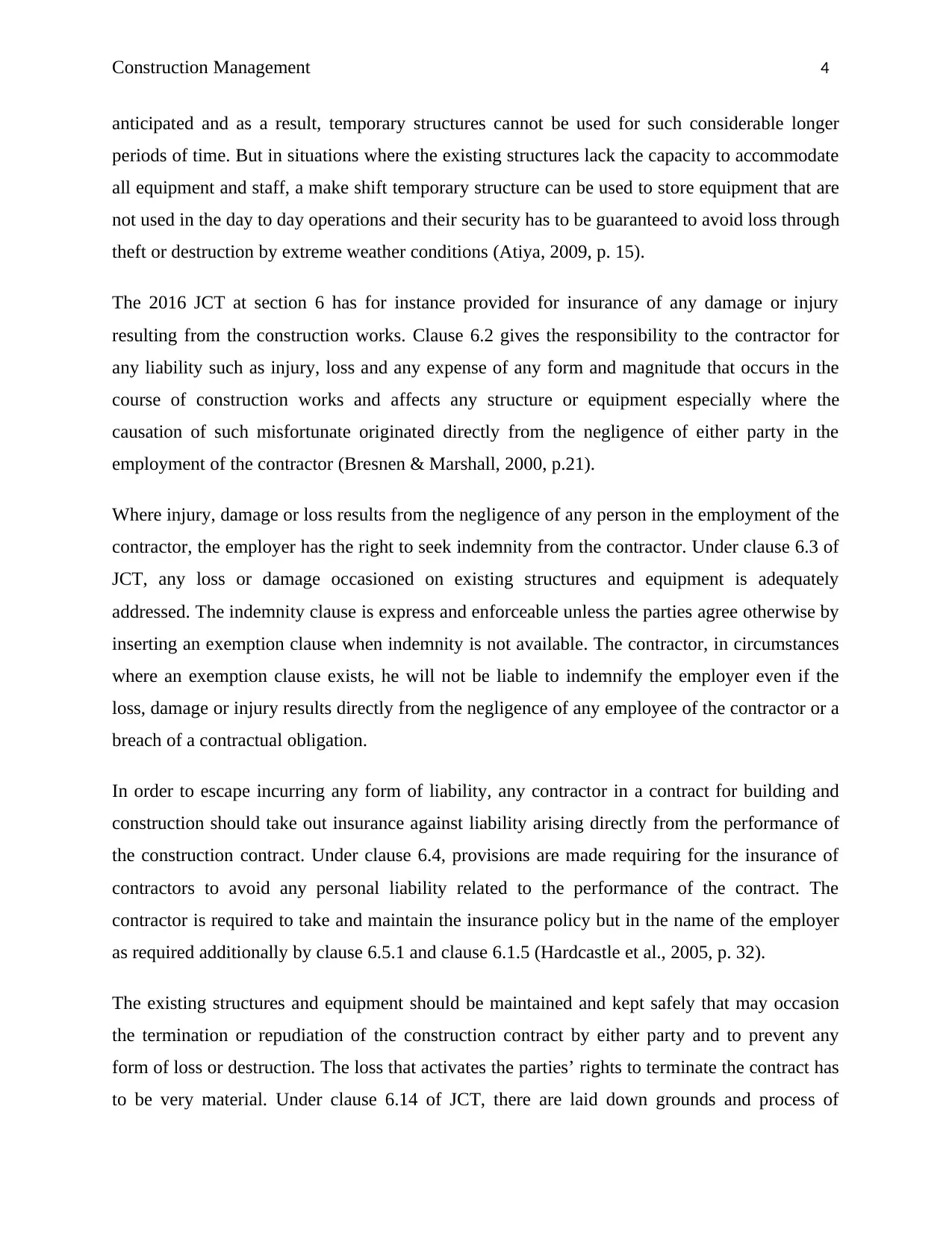
Construction Management 4
anticipated and as a result, temporary structures cannot be used for such considerable longer
periods of time. But in situations where the existing structures lack the capacity to accommodate
all equipment and staff, a make shift temporary structure can be used to store equipment that are
not used in the day to day operations and their security has to be guaranteed to avoid loss through
theft or destruction by extreme weather conditions (Atiya, 2009, p. 15).
The 2016 JCT at section 6 has for instance provided for insurance of any damage or injury
resulting from the construction works. Clause 6.2 gives the responsibility to the contractor for
any liability such as injury, loss and any expense of any form and magnitude that occurs in the
course of construction works and affects any structure or equipment especially where the
causation of such misfortunate originated directly from the negligence of either party in the
employment of the contractor (Bresnen & Marshall, 2000, p.21).
Where injury, damage or loss results from the negligence of any person in the employment of the
contractor, the employer has the right to seek indemnity from the contractor. Under clause 6.3 of
JCT, any loss or damage occasioned on existing structures and equipment is adequately
addressed. The indemnity clause is express and enforceable unless the parties agree otherwise by
inserting an exemption clause when indemnity is not available. The contractor, in circumstances
where an exemption clause exists, he will not be liable to indemnify the employer even if the
loss, damage or injury results directly from the negligence of any employee of the contractor or a
breach of a contractual obligation.
In order to escape incurring any form of liability, any contractor in a contract for building and
construction should take out insurance against liability arising directly from the performance of
the construction contract. Under clause 6.4, provisions are made requiring for the insurance of
contractors to avoid any personal liability related to the performance of the contract. The
contractor is required to take and maintain the insurance policy but in the name of the employer
as required additionally by clause 6.5.1 and clause 6.1.5 (Hardcastle et al., 2005, p. 32).
The existing structures and equipment should be maintained and kept safely that may occasion
the termination or repudiation of the construction contract by either party and to prevent any
form of loss or destruction. The loss that activates the parties’ rights to terminate the contract has
to be very material. Under clause 6.14 of JCT, there are laid down grounds and process of
anticipated and as a result, temporary structures cannot be used for such considerable longer
periods of time. But in situations where the existing structures lack the capacity to accommodate
all equipment and staff, a make shift temporary structure can be used to store equipment that are
not used in the day to day operations and their security has to be guaranteed to avoid loss through
theft or destruction by extreme weather conditions (Atiya, 2009, p. 15).
The 2016 JCT at section 6 has for instance provided for insurance of any damage or injury
resulting from the construction works. Clause 6.2 gives the responsibility to the contractor for
any liability such as injury, loss and any expense of any form and magnitude that occurs in the
course of construction works and affects any structure or equipment especially where the
causation of such misfortunate originated directly from the negligence of either party in the
employment of the contractor (Bresnen & Marshall, 2000, p.21).
Where injury, damage or loss results from the negligence of any person in the employment of the
contractor, the employer has the right to seek indemnity from the contractor. Under clause 6.3 of
JCT, any loss or damage occasioned on existing structures and equipment is adequately
addressed. The indemnity clause is express and enforceable unless the parties agree otherwise by
inserting an exemption clause when indemnity is not available. The contractor, in circumstances
where an exemption clause exists, he will not be liable to indemnify the employer even if the
loss, damage or injury results directly from the negligence of any employee of the contractor or a
breach of a contractual obligation.
In order to escape incurring any form of liability, any contractor in a contract for building and
construction should take out insurance against liability arising directly from the performance of
the construction contract. Under clause 6.4, provisions are made requiring for the insurance of
contractors to avoid any personal liability related to the performance of the contract. The
contractor is required to take and maintain the insurance policy but in the name of the employer
as required additionally by clause 6.5.1 and clause 6.1.5 (Hardcastle et al., 2005, p. 32).
The existing structures and equipment should be maintained and kept safely that may occasion
the termination or repudiation of the construction contract by either party and to prevent any
form of loss or destruction. The loss that activates the parties’ rights to terminate the contract has
to be very material. Under clause 6.14 of JCT, there are laid down grounds and process of
Secure Best Marks with AI Grader
Need help grading? Try our AI Grader for instant feedback on your assignments.
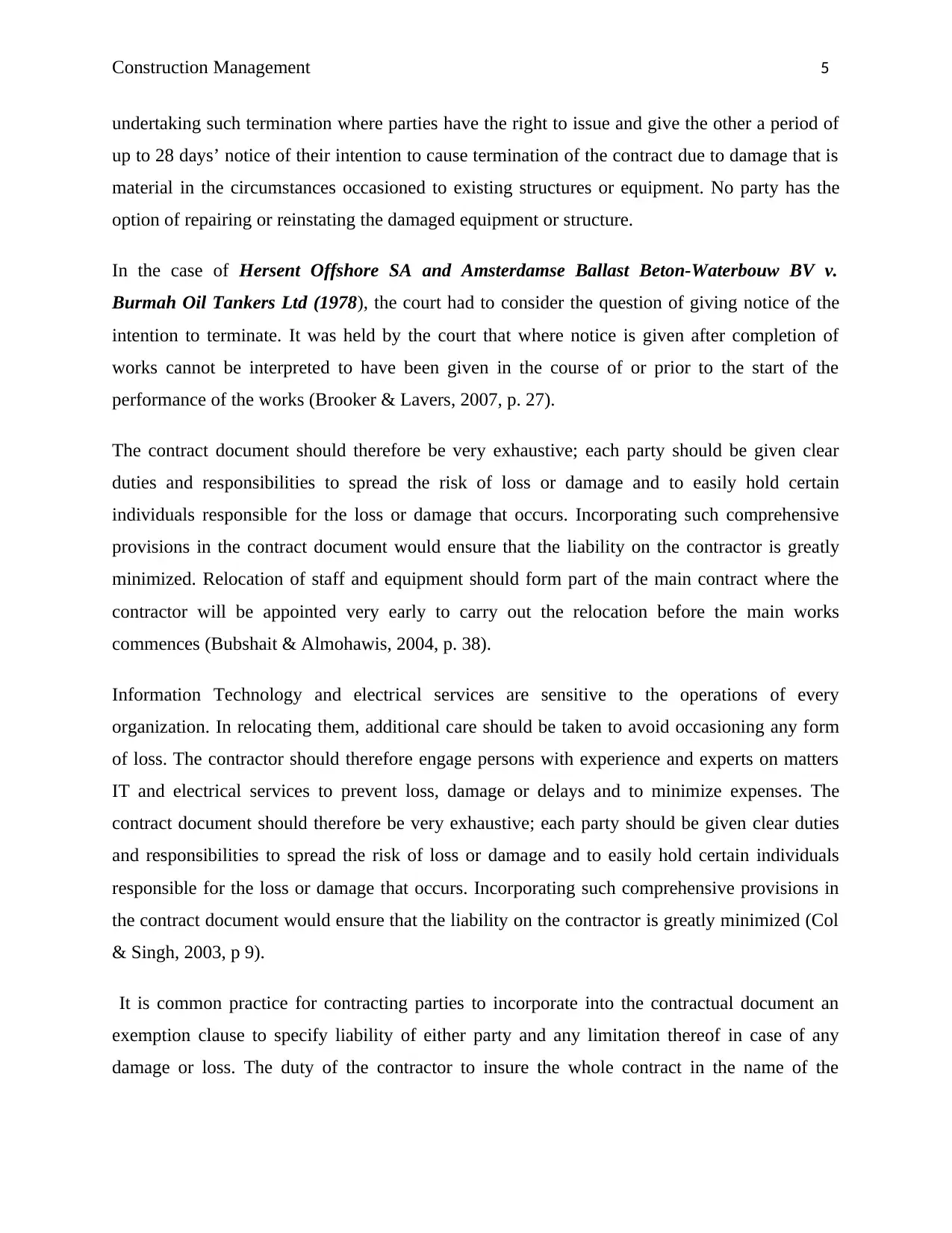
Construction Management 5
undertaking such termination where parties have the right to issue and give the other a period of
up to 28 days’ notice of their intention to cause termination of the contract due to damage that is
material in the circumstances occasioned to existing structures or equipment. No party has the
option of repairing or reinstating the damaged equipment or structure.
In the case of Hersent Offshore SA and Amsterdamse Ballast Beton-Waterbouw BV v.
Burmah Oil Tankers Ltd (1978), the court had to consider the question of giving notice of the
intention to terminate. It was held by the court that where notice is given after completion of
works cannot be interpreted to have been given in the course of or prior to the start of the
performance of the works (Brooker & Lavers, 2007, p. 27).
The contract document should therefore be very exhaustive; each party should be given clear
duties and responsibilities to spread the risk of loss or damage and to easily hold certain
individuals responsible for the loss or damage that occurs. Incorporating such comprehensive
provisions in the contract document would ensure that the liability on the contractor is greatly
minimized. Relocation of staff and equipment should form part of the main contract where the
contractor will be appointed very early to carry out the relocation before the main works
commences (Bubshait & Almohawis, 2004, p. 38).
Information Technology and electrical services are sensitive to the operations of every
organization. In relocating them, additional care should be taken to avoid occasioning any form
of loss. The contractor should therefore engage persons with experience and experts on matters
IT and electrical services to prevent loss, damage or delays and to minimize expenses. The
contract document should therefore be very exhaustive; each party should be given clear duties
and responsibilities to spread the risk of loss or damage and to easily hold certain individuals
responsible for the loss or damage that occurs. Incorporating such comprehensive provisions in
the contract document would ensure that the liability on the contractor is greatly minimized (Col
& Singh, 2003, p 9).
It is common practice for contracting parties to incorporate into the contractual document an
exemption clause to specify liability of either party and any limitation thereof in case of any
damage or loss. The duty of the contractor to insure the whole contract in the name of the
undertaking such termination where parties have the right to issue and give the other a period of
up to 28 days’ notice of their intention to cause termination of the contract due to damage that is
material in the circumstances occasioned to existing structures or equipment. No party has the
option of repairing or reinstating the damaged equipment or structure.
In the case of Hersent Offshore SA and Amsterdamse Ballast Beton-Waterbouw BV v.
Burmah Oil Tankers Ltd (1978), the court had to consider the question of giving notice of the
intention to terminate. It was held by the court that where notice is given after completion of
works cannot be interpreted to have been given in the course of or prior to the start of the
performance of the works (Brooker & Lavers, 2007, p. 27).
The contract document should therefore be very exhaustive; each party should be given clear
duties and responsibilities to spread the risk of loss or damage and to easily hold certain
individuals responsible for the loss or damage that occurs. Incorporating such comprehensive
provisions in the contract document would ensure that the liability on the contractor is greatly
minimized. Relocation of staff and equipment should form part of the main contract where the
contractor will be appointed very early to carry out the relocation before the main works
commences (Bubshait & Almohawis, 2004, p. 38).
Information Technology and electrical services are sensitive to the operations of every
organization. In relocating them, additional care should be taken to avoid occasioning any form
of loss. The contractor should therefore engage persons with experience and experts on matters
IT and electrical services to prevent loss, damage or delays and to minimize expenses. The
contract document should therefore be very exhaustive; each party should be given clear duties
and responsibilities to spread the risk of loss or damage and to easily hold certain individuals
responsible for the loss or damage that occurs. Incorporating such comprehensive provisions in
the contract document would ensure that the liability on the contractor is greatly minimized (Col
& Singh, 2003, p 9).
It is common practice for contracting parties to incorporate into the contractual document an
exemption clause to specify liability of either party and any limitation thereof in case of any
damage or loss. The duty of the contractor to insure the whole contract in the name of the
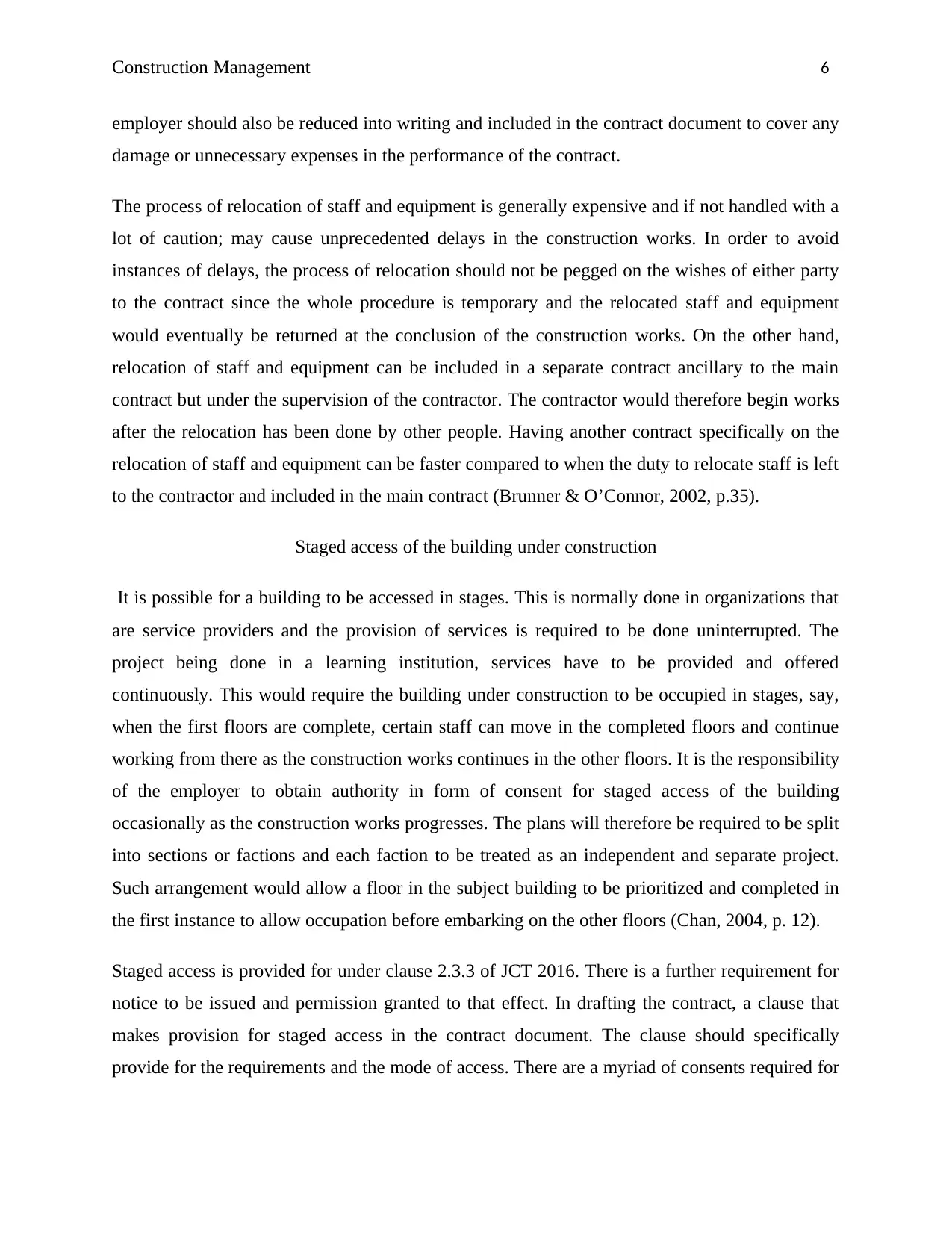
Construction Management 6
employer should also be reduced into writing and included in the contract document to cover any
damage or unnecessary expenses in the performance of the contract.
The process of relocation of staff and equipment is generally expensive and if not handled with a
lot of caution; may cause unprecedented delays in the construction works. In order to avoid
instances of delays, the process of relocation should not be pegged on the wishes of either party
to the contract since the whole procedure is temporary and the relocated staff and equipment
would eventually be returned at the conclusion of the construction works. On the other hand,
relocation of staff and equipment can be included in a separate contract ancillary to the main
contract but under the supervision of the contractor. The contractor would therefore begin works
after the relocation has been done by other people. Having another contract specifically on the
relocation of staff and equipment can be faster compared to when the duty to relocate staff is left
to the contractor and included in the main contract (Brunner & O’Connor, 2002, p.35).
Staged access of the building under construction
It is possible for a building to be accessed in stages. This is normally done in organizations that
are service providers and the provision of services is required to be done uninterrupted. The
project being done in a learning institution, services have to be provided and offered
continuously. This would require the building under construction to be occupied in stages, say,
when the first floors are complete, certain staff can move in the completed floors and continue
working from there as the construction works continues in the other floors. It is the responsibility
of the employer to obtain authority in form of consent for staged access of the building
occasionally as the construction works progresses. The plans will therefore be required to be split
into sections or factions and each faction to be treated as an independent and separate project.
Such arrangement would allow a floor in the subject building to be prioritized and completed in
the first instance to allow occupation before embarking on the other floors (Chan, 2004, p. 12).
Staged access is provided for under clause 2.3.3 of JCT 2016. There is a further requirement for
notice to be issued and permission granted to that effect. In drafting the contract, a clause that
makes provision for staged access in the contract document. The clause should specifically
provide for the requirements and the mode of access. There are a myriad of consents required for
employer should also be reduced into writing and included in the contract document to cover any
damage or unnecessary expenses in the performance of the contract.
The process of relocation of staff and equipment is generally expensive and if not handled with a
lot of caution; may cause unprecedented delays in the construction works. In order to avoid
instances of delays, the process of relocation should not be pegged on the wishes of either party
to the contract since the whole procedure is temporary and the relocated staff and equipment
would eventually be returned at the conclusion of the construction works. On the other hand,
relocation of staff and equipment can be included in a separate contract ancillary to the main
contract but under the supervision of the contractor. The contractor would therefore begin works
after the relocation has been done by other people. Having another contract specifically on the
relocation of staff and equipment can be faster compared to when the duty to relocate staff is left
to the contractor and included in the main contract (Brunner & O’Connor, 2002, p.35).
Staged access of the building under construction
It is possible for a building to be accessed in stages. This is normally done in organizations that
are service providers and the provision of services is required to be done uninterrupted. The
project being done in a learning institution, services have to be provided and offered
continuously. This would require the building under construction to be occupied in stages, say,
when the first floors are complete, certain staff can move in the completed floors and continue
working from there as the construction works continues in the other floors. It is the responsibility
of the employer to obtain authority in form of consent for staged access of the building
occasionally as the construction works progresses. The plans will therefore be required to be split
into sections or factions and each faction to be treated as an independent and separate project.
Such arrangement would allow a floor in the subject building to be prioritized and completed in
the first instance to allow occupation before embarking on the other floors (Chan, 2004, p. 12).
Staged access is provided for under clause 2.3.3 of JCT 2016. There is a further requirement for
notice to be issued and permission granted to that effect. In drafting the contract, a clause that
makes provision for staged access in the contract document. The clause should specifically
provide for the requirements and the mode of access. There are a myriad of consents required for
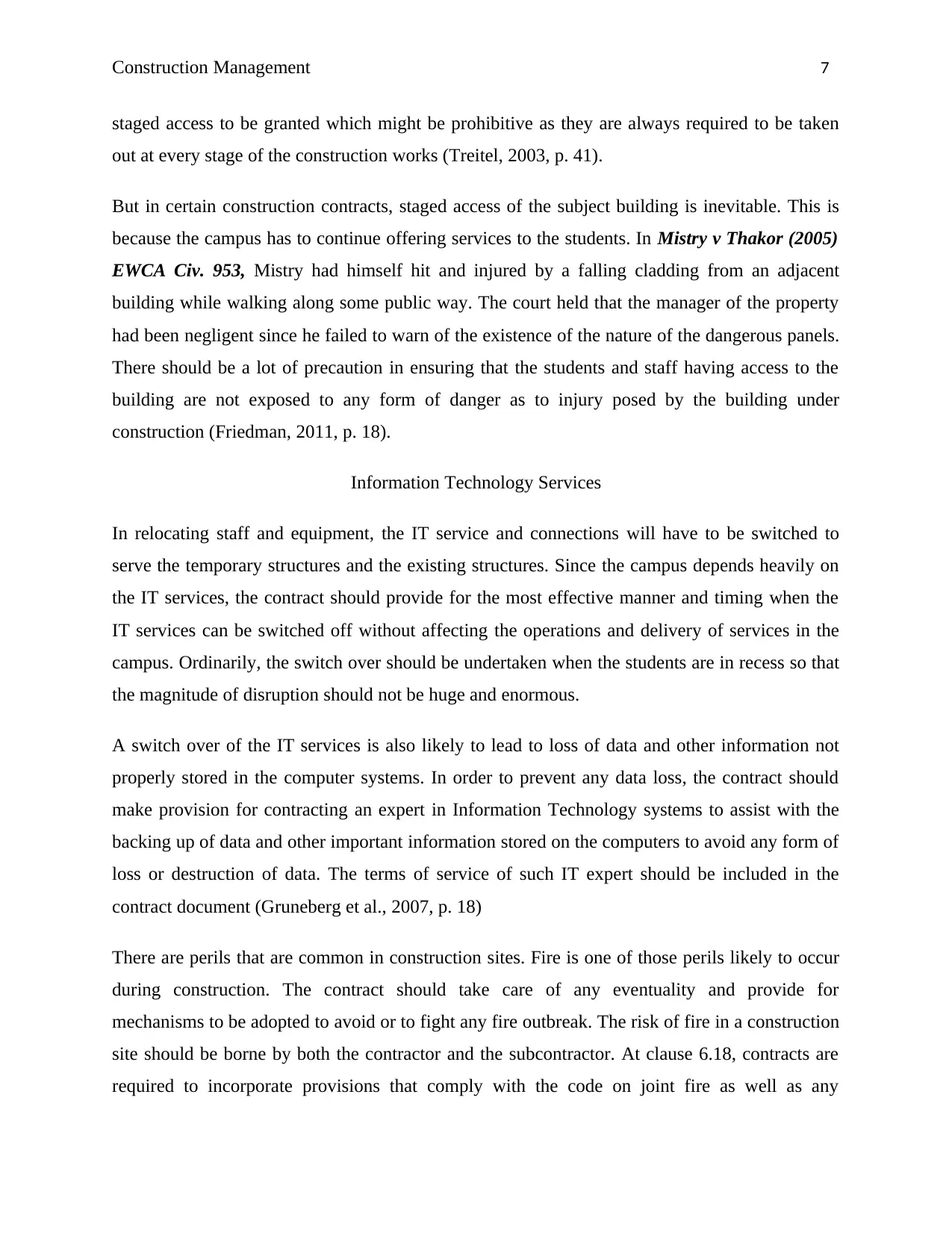
Construction Management 7
staged access to be granted which might be prohibitive as they are always required to be taken
out at every stage of the construction works (Treitel, 2003, p. 41).
But in certain construction contracts, staged access of the subject building is inevitable. This is
because the campus has to continue offering services to the students. In Mistry v Thakor (2005)
EWCA Civ. 953, Mistry had himself hit and injured by a falling cladding from an adjacent
building while walking along some public way. The court held that the manager of the property
had been negligent since he failed to warn of the existence of the nature of the dangerous panels.
There should be a lot of precaution in ensuring that the students and staff having access to the
building are not exposed to any form of danger as to injury posed by the building under
construction (Friedman, 2011, p. 18).
Information Technology Services
In relocating staff and equipment, the IT service and connections will have to be switched to
serve the temporary structures and the existing structures. Since the campus depends heavily on
the IT services, the contract should provide for the most effective manner and timing when the
IT services can be switched off without affecting the operations and delivery of services in the
campus. Ordinarily, the switch over should be undertaken when the students are in recess so that
the magnitude of disruption should not be huge and enormous.
A switch over of the IT services is also likely to lead to loss of data and other information not
properly stored in the computer systems. In order to prevent any data loss, the contract should
make provision for contracting an expert in Information Technology systems to assist with the
backing up of data and other important information stored on the computers to avoid any form of
loss or destruction of data. The terms of service of such IT expert should be included in the
contract document (Gruneberg et al., 2007, p. 18)
There are perils that are common in construction sites. Fire is one of those perils likely to occur
during construction. The contract should take care of any eventuality and provide for
mechanisms to be adopted to avoid or to fight any fire outbreak. The risk of fire in a construction
site should be borne by both the contractor and the subcontractor. At clause 6.18, contracts are
required to incorporate provisions that comply with the code on joint fire as well as any
staged access to be granted which might be prohibitive as they are always required to be taken
out at every stage of the construction works (Treitel, 2003, p. 41).
But in certain construction contracts, staged access of the subject building is inevitable. This is
because the campus has to continue offering services to the students. In Mistry v Thakor (2005)
EWCA Civ. 953, Mistry had himself hit and injured by a falling cladding from an adjacent
building while walking along some public way. The court held that the manager of the property
had been negligent since he failed to warn of the existence of the nature of the dangerous panels.
There should be a lot of precaution in ensuring that the students and staff having access to the
building are not exposed to any form of danger as to injury posed by the building under
construction (Friedman, 2011, p. 18).
Information Technology Services
In relocating staff and equipment, the IT service and connections will have to be switched to
serve the temporary structures and the existing structures. Since the campus depends heavily on
the IT services, the contract should provide for the most effective manner and timing when the
IT services can be switched off without affecting the operations and delivery of services in the
campus. Ordinarily, the switch over should be undertaken when the students are in recess so that
the magnitude of disruption should not be huge and enormous.
A switch over of the IT services is also likely to lead to loss of data and other information not
properly stored in the computer systems. In order to prevent any data loss, the contract should
make provision for contracting an expert in Information Technology systems to assist with the
backing up of data and other important information stored on the computers to avoid any form of
loss or destruction of data. The terms of service of such IT expert should be included in the
contract document (Gruneberg et al., 2007, p. 18)
There are perils that are common in construction sites. Fire is one of those perils likely to occur
during construction. The contract should take care of any eventuality and provide for
mechanisms to be adopted to avoid or to fight any fire outbreak. The risk of fire in a construction
site should be borne by both the contractor and the subcontractor. At clause 6.18, contracts are
required to incorporate provisions that comply with the code on joint fire as well as any
Paraphrase This Document
Need a fresh take? Get an instant paraphrase of this document with our AI Paraphraser
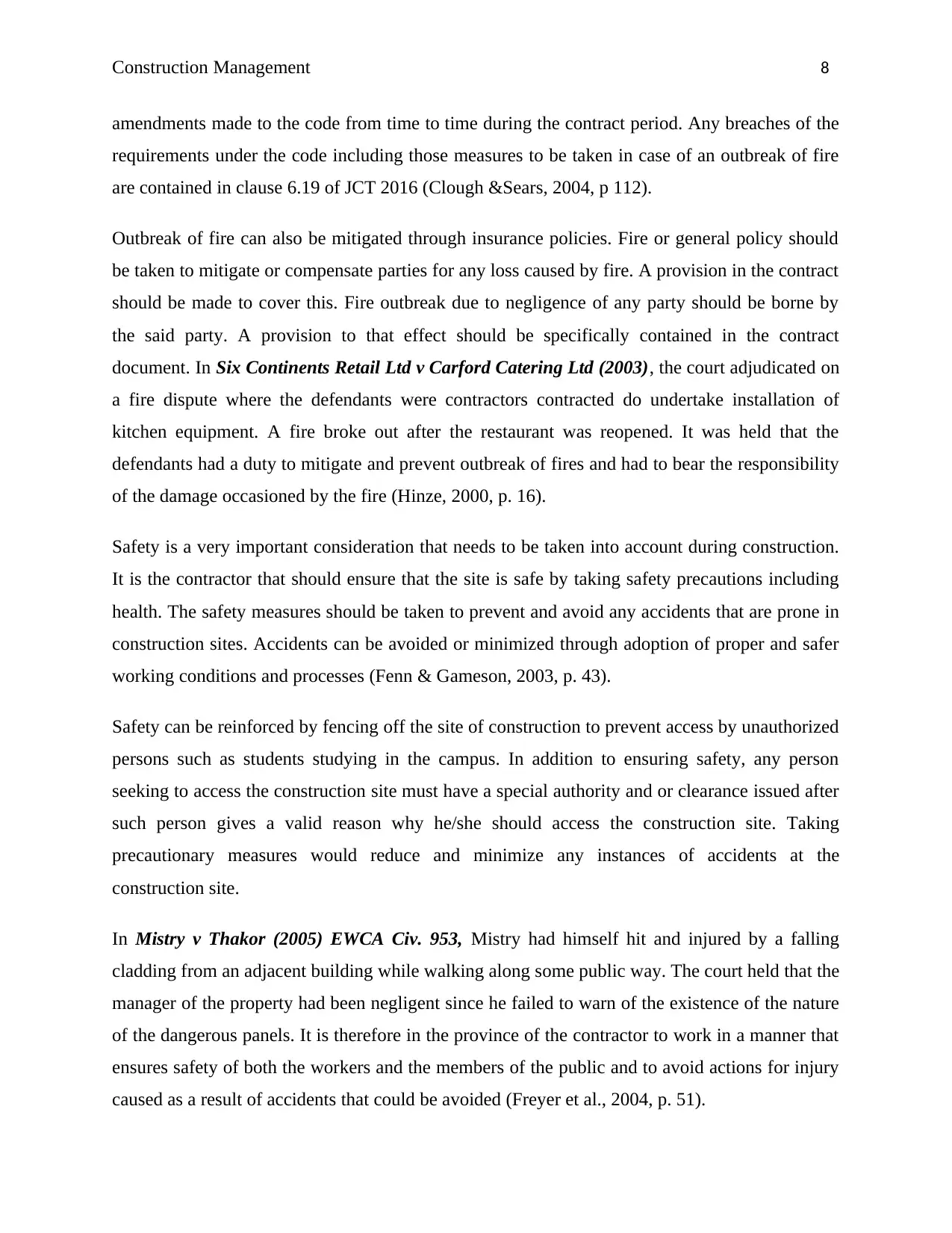
Construction Management 8
amendments made to the code from time to time during the contract period. Any breaches of the
requirements under the code including those measures to be taken in case of an outbreak of fire
are contained in clause 6.19 of JCT 2016 (Clough &Sears, 2004, p 112).
Outbreak of fire can also be mitigated through insurance policies. Fire or general policy should
be taken to mitigate or compensate parties for any loss caused by fire. A provision in the contract
should be made to cover this. Fire outbreak due to negligence of any party should be borne by
the said party. A provision to that effect should be specifically contained in the contract
document. In Six Continents Retail Ltd v Carford Catering Ltd (2003), the court adjudicated on
a fire dispute where the defendants were contractors contracted do undertake installation of
kitchen equipment. A fire broke out after the restaurant was reopened. It was held that the
defendants had a duty to mitigate and prevent outbreak of fires and had to bear the responsibility
of the damage occasioned by the fire (Hinze, 2000, p. 16).
Safety is a very important consideration that needs to be taken into account during construction.
It is the contractor that should ensure that the site is safe by taking safety precautions including
health. The safety measures should be taken to prevent and avoid any accidents that are prone in
construction sites. Accidents can be avoided or minimized through adoption of proper and safer
working conditions and processes (Fenn & Gameson, 2003, p. 43).
Safety can be reinforced by fencing off the site of construction to prevent access by unauthorized
persons such as students studying in the campus. In addition to ensuring safety, any person
seeking to access the construction site must have a special authority and or clearance issued after
such person gives a valid reason why he/she should access the construction site. Taking
precautionary measures would reduce and minimize any instances of accidents at the
construction site.
In Mistry v Thakor (2005) EWCA Civ. 953, Mistry had himself hit and injured by a falling
cladding from an adjacent building while walking along some public way. The court held that the
manager of the property had been negligent since he failed to warn of the existence of the nature
of the dangerous panels. It is therefore in the province of the contractor to work in a manner that
ensures safety of both the workers and the members of the public and to avoid actions for injury
caused as a result of accidents that could be avoided (Freyer et al., 2004, p. 51).
amendments made to the code from time to time during the contract period. Any breaches of the
requirements under the code including those measures to be taken in case of an outbreak of fire
are contained in clause 6.19 of JCT 2016 (Clough &Sears, 2004, p 112).
Outbreak of fire can also be mitigated through insurance policies. Fire or general policy should
be taken to mitigate or compensate parties for any loss caused by fire. A provision in the contract
should be made to cover this. Fire outbreak due to negligence of any party should be borne by
the said party. A provision to that effect should be specifically contained in the contract
document. In Six Continents Retail Ltd v Carford Catering Ltd (2003), the court adjudicated on
a fire dispute where the defendants were contractors contracted do undertake installation of
kitchen equipment. A fire broke out after the restaurant was reopened. It was held that the
defendants had a duty to mitigate and prevent outbreak of fires and had to bear the responsibility
of the damage occasioned by the fire (Hinze, 2000, p. 16).
Safety is a very important consideration that needs to be taken into account during construction.
It is the contractor that should ensure that the site is safe by taking safety precautions including
health. The safety measures should be taken to prevent and avoid any accidents that are prone in
construction sites. Accidents can be avoided or minimized through adoption of proper and safer
working conditions and processes (Fenn & Gameson, 2003, p. 43).
Safety can be reinforced by fencing off the site of construction to prevent access by unauthorized
persons such as students studying in the campus. In addition to ensuring safety, any person
seeking to access the construction site must have a special authority and or clearance issued after
such person gives a valid reason why he/she should access the construction site. Taking
precautionary measures would reduce and minimize any instances of accidents at the
construction site.
In Mistry v Thakor (2005) EWCA Civ. 953, Mistry had himself hit and injured by a falling
cladding from an adjacent building while walking along some public way. The court held that the
manager of the property had been negligent since he failed to warn of the existence of the nature
of the dangerous panels. It is therefore in the province of the contractor to work in a manner that
ensures safety of both the workers and the members of the public and to avoid actions for injury
caused as a result of accidents that could be avoided (Freyer et al., 2004, p. 51).
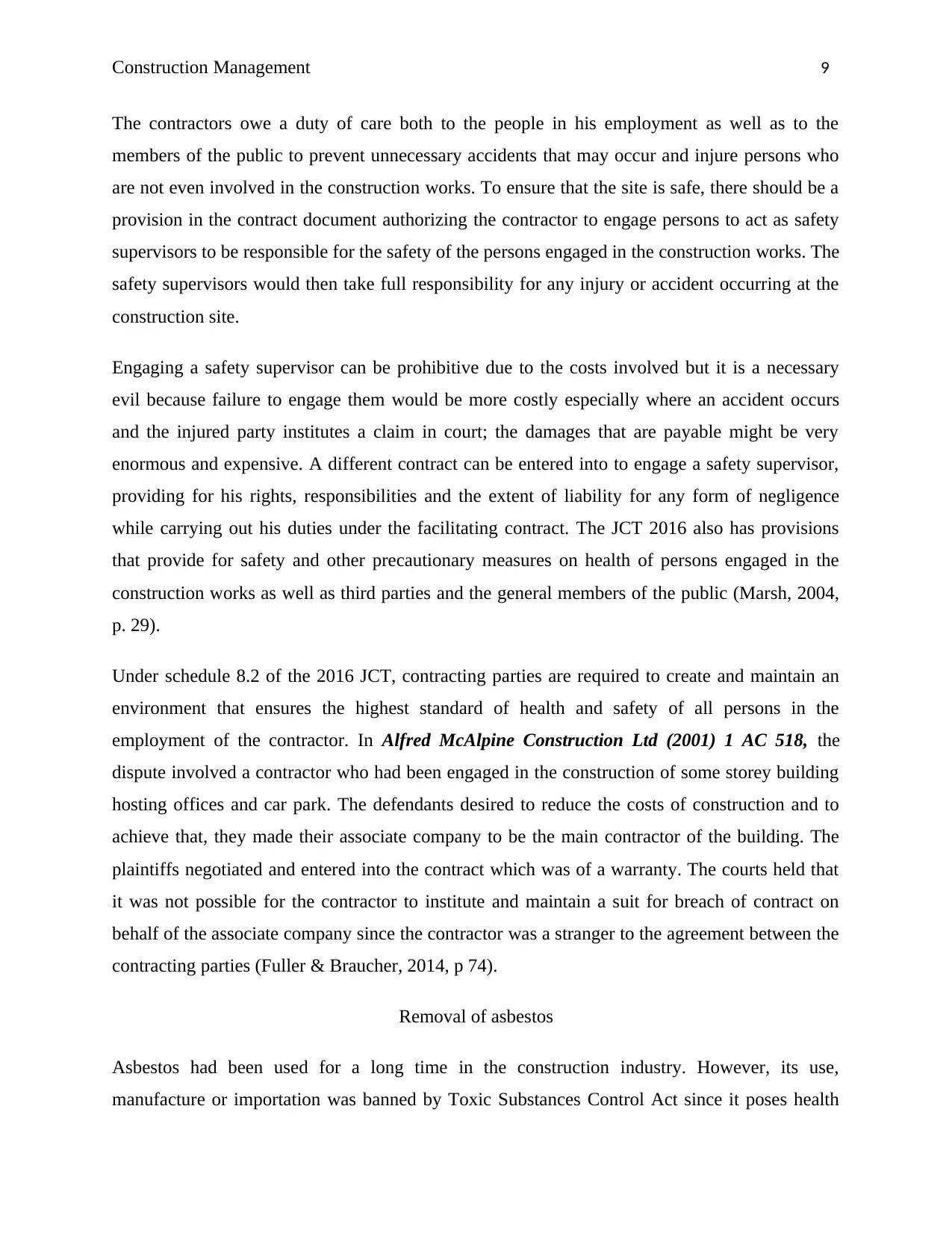
Construction Management 9
The contractors owe a duty of care both to the people in his employment as well as to the
members of the public to prevent unnecessary accidents that may occur and injure persons who
are not even involved in the construction works. To ensure that the site is safe, there should be a
provision in the contract document authorizing the contractor to engage persons to act as safety
supervisors to be responsible for the safety of the persons engaged in the construction works. The
safety supervisors would then take full responsibility for any injury or accident occurring at the
construction site.
Engaging a safety supervisor can be prohibitive due to the costs involved but it is a necessary
evil because failure to engage them would be more costly especially where an accident occurs
and the injured party institutes a claim in court; the damages that are payable might be very
enormous and expensive. A different contract can be entered into to engage a safety supervisor,
providing for his rights, responsibilities and the extent of liability for any form of negligence
while carrying out his duties under the facilitating contract. The JCT 2016 also has provisions
that provide for safety and other precautionary measures on health of persons engaged in the
construction works as well as third parties and the general members of the public (Marsh, 2004,
p. 29).
Under schedule 8.2 of the 2016 JCT, contracting parties are required to create and maintain an
environment that ensures the highest standard of health and safety of all persons in the
employment of the contractor. In Alfred McAlpine Construction Ltd (2001) 1 AC 518, the
dispute involved a contractor who had been engaged in the construction of some storey building
hosting offices and car park. The defendants desired to reduce the costs of construction and to
achieve that, they made their associate company to be the main contractor of the building. The
plaintiffs negotiated and entered into the contract which was of a warranty. The courts held that
it was not possible for the contractor to institute and maintain a suit for breach of contract on
behalf of the associate company since the contractor was a stranger to the agreement between the
contracting parties (Fuller & Braucher, 2014, p 74).
Removal of asbestos
Asbestos had been used for a long time in the construction industry. However, its use,
manufacture or importation was banned by Toxic Substances Control Act since it poses health
The contractors owe a duty of care both to the people in his employment as well as to the
members of the public to prevent unnecessary accidents that may occur and injure persons who
are not even involved in the construction works. To ensure that the site is safe, there should be a
provision in the contract document authorizing the contractor to engage persons to act as safety
supervisors to be responsible for the safety of the persons engaged in the construction works. The
safety supervisors would then take full responsibility for any injury or accident occurring at the
construction site.
Engaging a safety supervisor can be prohibitive due to the costs involved but it is a necessary
evil because failure to engage them would be more costly especially where an accident occurs
and the injured party institutes a claim in court; the damages that are payable might be very
enormous and expensive. A different contract can be entered into to engage a safety supervisor,
providing for his rights, responsibilities and the extent of liability for any form of negligence
while carrying out his duties under the facilitating contract. The JCT 2016 also has provisions
that provide for safety and other precautionary measures on health of persons engaged in the
construction works as well as third parties and the general members of the public (Marsh, 2004,
p. 29).
Under schedule 8.2 of the 2016 JCT, contracting parties are required to create and maintain an
environment that ensures the highest standard of health and safety of all persons in the
employment of the contractor. In Alfred McAlpine Construction Ltd (2001) 1 AC 518, the
dispute involved a contractor who had been engaged in the construction of some storey building
hosting offices and car park. The defendants desired to reduce the costs of construction and to
achieve that, they made their associate company to be the main contractor of the building. The
plaintiffs negotiated and entered into the contract which was of a warranty. The courts held that
it was not possible for the contractor to institute and maintain a suit for breach of contract on
behalf of the associate company since the contractor was a stranger to the agreement between the
contracting parties (Fuller & Braucher, 2014, p 74).
Removal of asbestos
Asbestos had been used for a long time in the construction industry. However, its use,
manufacture or importation was banned by Toxic Substances Control Act since it poses health
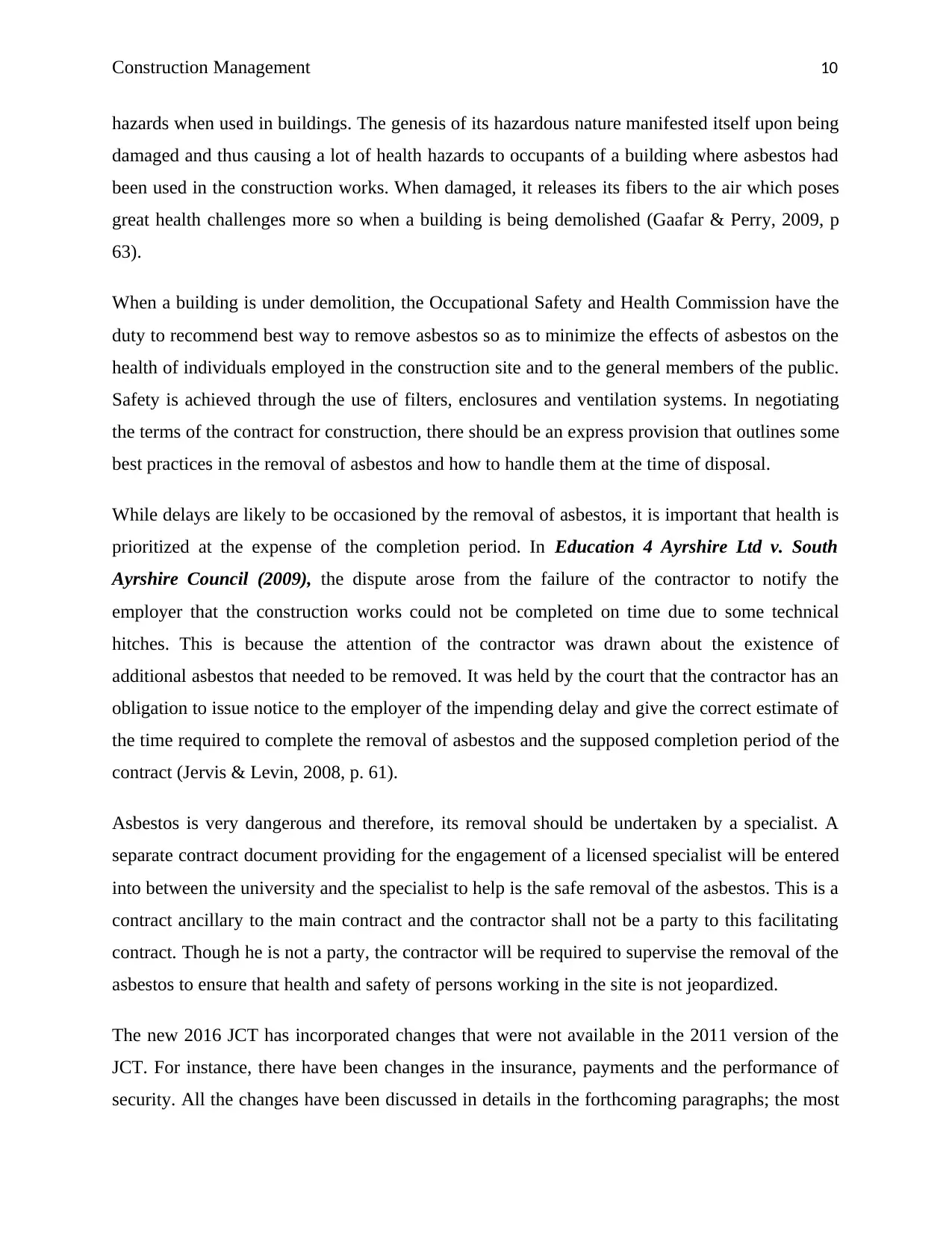
Construction Management 10
hazards when used in buildings. The genesis of its hazardous nature manifested itself upon being
damaged and thus causing a lot of health hazards to occupants of a building where asbestos had
been used in the construction works. When damaged, it releases its fibers to the air which poses
great health challenges more so when a building is being demolished (Gaafar & Perry, 2009, p
63).
When a building is under demolition, the Occupational Safety and Health Commission have the
duty to recommend best way to remove asbestos so as to minimize the effects of asbestos on the
health of individuals employed in the construction site and to the general members of the public.
Safety is achieved through the use of filters, enclosures and ventilation systems. In negotiating
the terms of the contract for construction, there should be an express provision that outlines some
best practices in the removal of asbestos and how to handle them at the time of disposal.
While delays are likely to be occasioned by the removal of asbestos, it is important that health is
prioritized at the expense of the completion period. In Education 4 Ayrshire Ltd v. South
Ayrshire Council (2009), the dispute arose from the failure of the contractor to notify the
employer that the construction works could not be completed on time due to some technical
hitches. This is because the attention of the contractor was drawn about the existence of
additional asbestos that needed to be removed. It was held by the court that the contractor has an
obligation to issue notice to the employer of the impending delay and give the correct estimate of
the time required to complete the removal of asbestos and the supposed completion period of the
contract (Jervis & Levin, 2008, p. 61).
Asbestos is very dangerous and therefore, its removal should be undertaken by a specialist. A
separate contract document providing for the engagement of a licensed specialist will be entered
into between the university and the specialist to help is the safe removal of the asbestos. This is a
contract ancillary to the main contract and the contractor shall not be a party to this facilitating
contract. Though he is not a party, the contractor will be required to supervise the removal of the
asbestos to ensure that health and safety of persons working in the site is not jeopardized.
The new 2016 JCT has incorporated changes that were not available in the 2011 version of the
JCT. For instance, there have been changes in the insurance, payments and the performance of
security. All the changes have been discussed in details in the forthcoming paragraphs; the most
hazards when used in buildings. The genesis of its hazardous nature manifested itself upon being
damaged and thus causing a lot of health hazards to occupants of a building where asbestos had
been used in the construction works. When damaged, it releases its fibers to the air which poses
great health challenges more so when a building is being demolished (Gaafar & Perry, 2009, p
63).
When a building is under demolition, the Occupational Safety and Health Commission have the
duty to recommend best way to remove asbestos so as to minimize the effects of asbestos on the
health of individuals employed in the construction site and to the general members of the public.
Safety is achieved through the use of filters, enclosures and ventilation systems. In negotiating
the terms of the contract for construction, there should be an express provision that outlines some
best practices in the removal of asbestos and how to handle them at the time of disposal.
While delays are likely to be occasioned by the removal of asbestos, it is important that health is
prioritized at the expense of the completion period. In Education 4 Ayrshire Ltd v. South
Ayrshire Council (2009), the dispute arose from the failure of the contractor to notify the
employer that the construction works could not be completed on time due to some technical
hitches. This is because the attention of the contractor was drawn about the existence of
additional asbestos that needed to be removed. It was held by the court that the contractor has an
obligation to issue notice to the employer of the impending delay and give the correct estimate of
the time required to complete the removal of asbestos and the supposed completion period of the
contract (Jervis & Levin, 2008, p. 61).
Asbestos is very dangerous and therefore, its removal should be undertaken by a specialist. A
separate contract document providing for the engagement of a licensed specialist will be entered
into between the university and the specialist to help is the safe removal of the asbestos. This is a
contract ancillary to the main contract and the contractor shall not be a party to this facilitating
contract. Though he is not a party, the contractor will be required to supervise the removal of the
asbestos to ensure that health and safety of persons working in the site is not jeopardized.
The new 2016 JCT has incorporated changes that were not available in the 2011 version of the
JCT. For instance, there have been changes in the insurance, payments and the performance of
security. All the changes have been discussed in details in the forthcoming paragraphs; the most
Secure Best Marks with AI Grader
Need help grading? Try our AI Grader for instant feedback on your assignments.
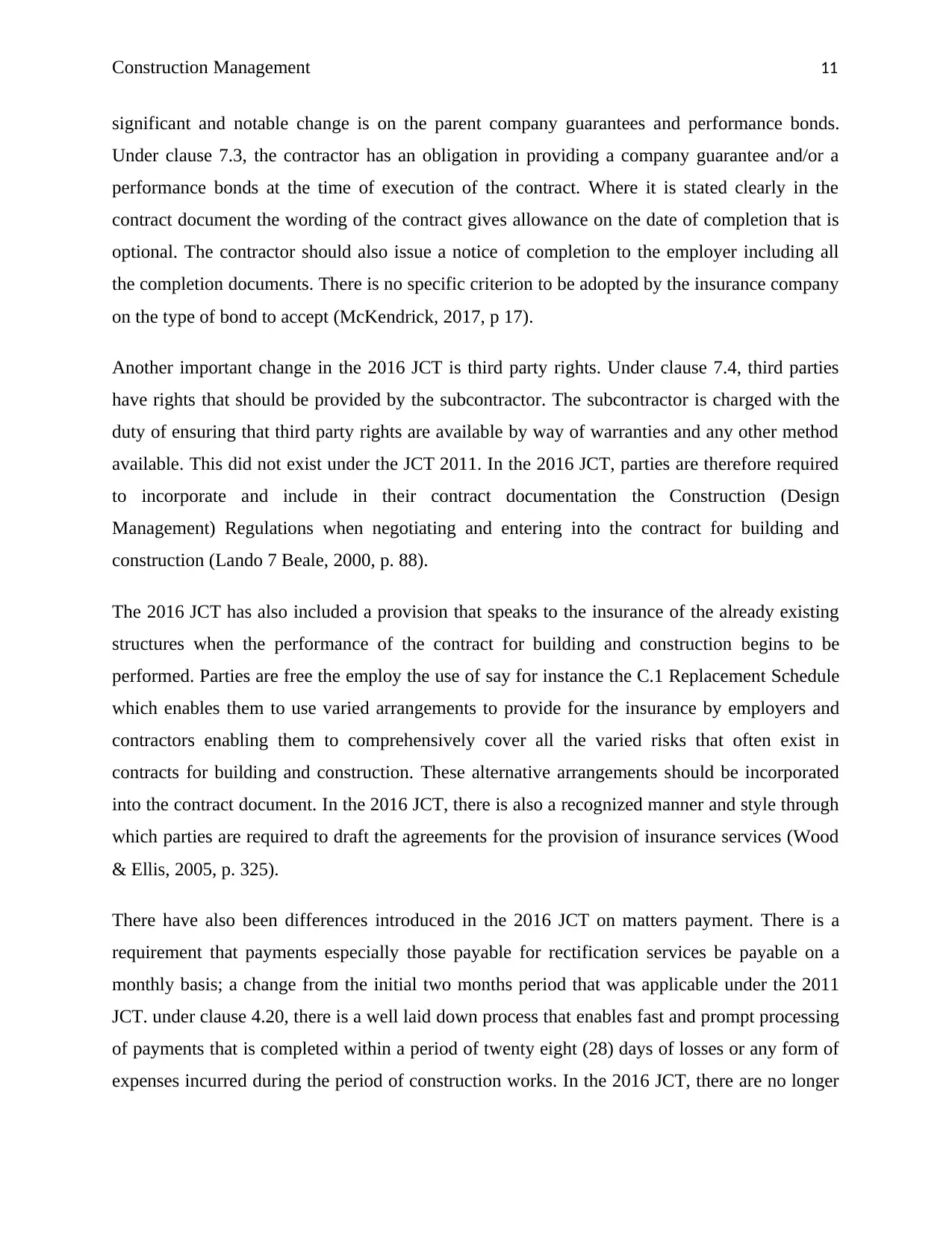
Construction Management 11
significant and notable change is on the parent company guarantees and performance bonds.
Under clause 7.3, the contractor has an obligation in providing a company guarantee and/or a
performance bonds at the time of execution of the contract. Where it is stated clearly in the
contract document the wording of the contract gives allowance on the date of completion that is
optional. The contractor should also issue a notice of completion to the employer including all
the completion documents. There is no specific criterion to be adopted by the insurance company
on the type of bond to accept (McKendrick, 2017, p 17).
Another important change in the 2016 JCT is third party rights. Under clause 7.4, third parties
have rights that should be provided by the subcontractor. The subcontractor is charged with the
duty of ensuring that third party rights are available by way of warranties and any other method
available. This did not exist under the JCT 2011. In the 2016 JCT, parties are therefore required
to incorporate and include in their contract documentation the Construction (Design
Management) Regulations when negotiating and entering into the contract for building and
construction (Lando 7 Beale, 2000, p. 88).
The 2016 JCT has also included a provision that speaks to the insurance of the already existing
structures when the performance of the contract for building and construction begins to be
performed. Parties are free the employ the use of say for instance the C.1 Replacement Schedule
which enables them to use varied arrangements to provide for the insurance by employers and
contractors enabling them to comprehensively cover all the varied risks that often exist in
contracts for building and construction. These alternative arrangements should be incorporated
into the contract document. In the 2016 JCT, there is also a recognized manner and style through
which parties are required to draft the agreements for the provision of insurance services (Wood
& Ellis, 2005, p. 325).
There have also been differences introduced in the 2016 JCT on matters payment. There is a
requirement that payments especially those payable for rectification services be payable on a
monthly basis; a change from the initial two months period that was applicable under the 2011
JCT. under clause 4.20, there is a well laid down process that enables fast and prompt processing
of payments that is completed within a period of twenty eight (28) days of losses or any form of
expenses incurred during the period of construction works. In the 2016 JCT, there are no longer
significant and notable change is on the parent company guarantees and performance bonds.
Under clause 7.3, the contractor has an obligation in providing a company guarantee and/or a
performance bonds at the time of execution of the contract. Where it is stated clearly in the
contract document the wording of the contract gives allowance on the date of completion that is
optional. The contractor should also issue a notice of completion to the employer including all
the completion documents. There is no specific criterion to be adopted by the insurance company
on the type of bond to accept (McKendrick, 2017, p 17).
Another important change in the 2016 JCT is third party rights. Under clause 7.4, third parties
have rights that should be provided by the subcontractor. The subcontractor is charged with the
duty of ensuring that third party rights are available by way of warranties and any other method
available. This did not exist under the JCT 2011. In the 2016 JCT, parties are therefore required
to incorporate and include in their contract documentation the Construction (Design
Management) Regulations when negotiating and entering into the contract for building and
construction (Lando 7 Beale, 2000, p. 88).
The 2016 JCT has also included a provision that speaks to the insurance of the already existing
structures when the performance of the contract for building and construction begins to be
performed. Parties are free the employ the use of say for instance the C.1 Replacement Schedule
which enables them to use varied arrangements to provide for the insurance by employers and
contractors enabling them to comprehensively cover all the varied risks that often exist in
contracts for building and construction. These alternative arrangements should be incorporated
into the contract document. In the 2016 JCT, there is also a recognized manner and style through
which parties are required to draft the agreements for the provision of insurance services (Wood
& Ellis, 2005, p. 325).
There have also been differences introduced in the 2016 JCT on matters payment. There is a
requirement that payments especially those payable for rectification services be payable on a
monthly basis; a change from the initial two months period that was applicable under the 2011
JCT. under clause 4.20, there is a well laid down process that enables fast and prompt processing
of payments that is completed within a period of twenty eight (28) days of losses or any form of
expenses incurred during the period of construction works. In the 2016 JCT, there are no longer
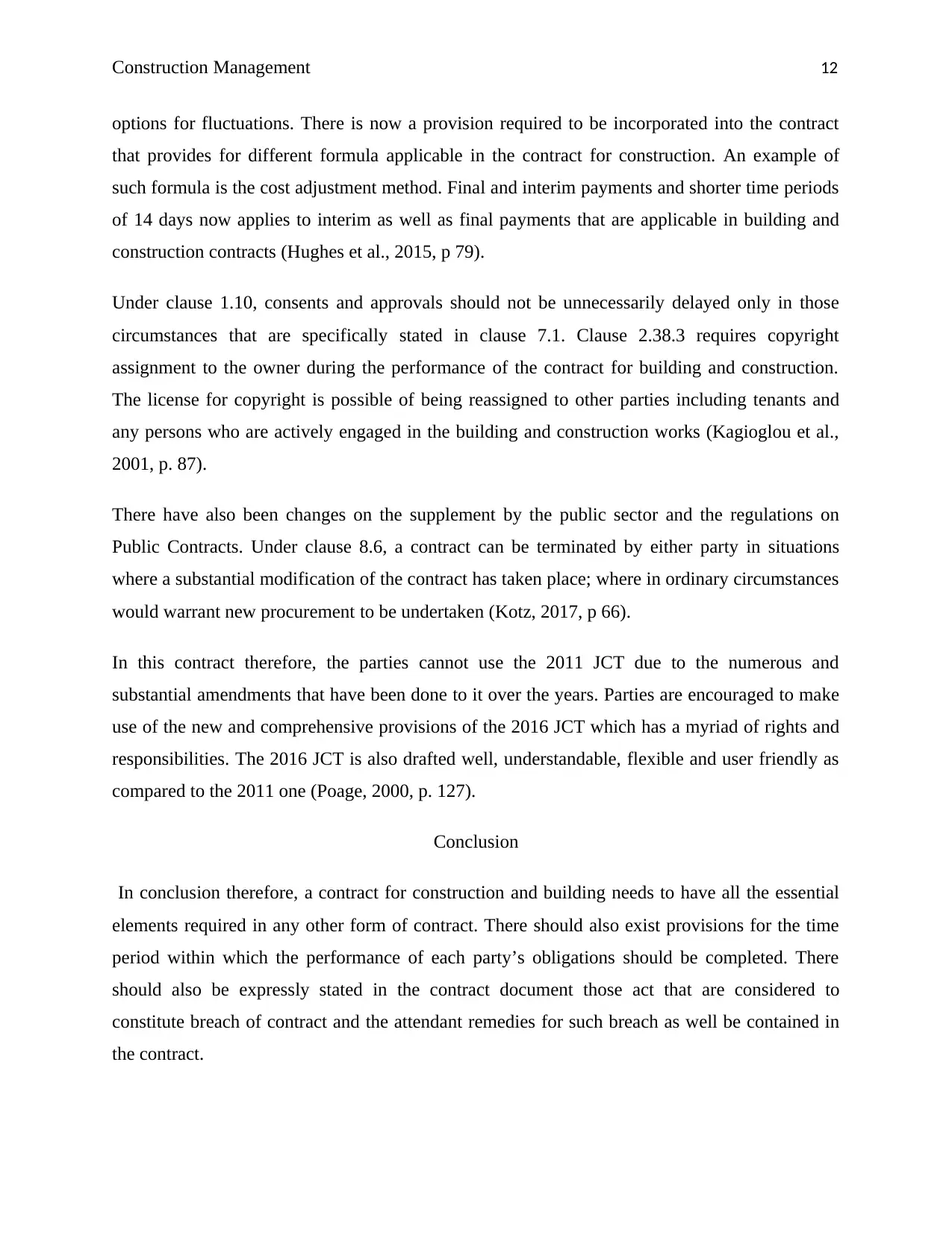
Construction Management 12
options for fluctuations. There is now a provision required to be incorporated into the contract
that provides for different formula applicable in the contract for construction. An example of
such formula is the cost adjustment method. Final and interim payments and shorter time periods
of 14 days now applies to interim as well as final payments that are applicable in building and
construction contracts (Hughes et al., 2015, p 79).
Under clause 1.10, consents and approvals should not be unnecessarily delayed only in those
circumstances that are specifically stated in clause 7.1. Clause 2.38.3 requires copyright
assignment to the owner during the performance of the contract for building and construction.
The license for copyright is possible of being reassigned to other parties including tenants and
any persons who are actively engaged in the building and construction works (Kagioglou et al.,
2001, p. 87).
There have also been changes on the supplement by the public sector and the regulations on
Public Contracts. Under clause 8.6, a contract can be terminated by either party in situations
where a substantial modification of the contract has taken place; where in ordinary circumstances
would warrant new procurement to be undertaken (Kotz, 2017, p 66).
In this contract therefore, the parties cannot use the 2011 JCT due to the numerous and
substantial amendments that have been done to it over the years. Parties are encouraged to make
use of the new and comprehensive provisions of the 2016 JCT which has a myriad of rights and
responsibilities. The 2016 JCT is also drafted well, understandable, flexible and user friendly as
compared to the 2011 one (Poage, 2000, p. 127).
Conclusion
In conclusion therefore, a contract for construction and building needs to have all the essential
elements required in any other form of contract. There should also exist provisions for the time
period within which the performance of each party’s obligations should be completed. There
should also be expressly stated in the contract document those act that are considered to
constitute breach of contract and the attendant remedies for such breach as well be contained in
the contract.
options for fluctuations. There is now a provision required to be incorporated into the contract
that provides for different formula applicable in the contract for construction. An example of
such formula is the cost adjustment method. Final and interim payments and shorter time periods
of 14 days now applies to interim as well as final payments that are applicable in building and
construction contracts (Hughes et al., 2015, p 79).
Under clause 1.10, consents and approvals should not be unnecessarily delayed only in those
circumstances that are specifically stated in clause 7.1. Clause 2.38.3 requires copyright
assignment to the owner during the performance of the contract for building and construction.
The license for copyright is possible of being reassigned to other parties including tenants and
any persons who are actively engaged in the building and construction works (Kagioglou et al.,
2001, p. 87).
There have also been changes on the supplement by the public sector and the regulations on
Public Contracts. Under clause 8.6, a contract can be terminated by either party in situations
where a substantial modification of the contract has taken place; where in ordinary circumstances
would warrant new procurement to be undertaken (Kotz, 2017, p 66).
In this contract therefore, the parties cannot use the 2011 JCT due to the numerous and
substantial amendments that have been done to it over the years. Parties are encouraged to make
use of the new and comprehensive provisions of the 2016 JCT which has a myriad of rights and
responsibilities. The 2016 JCT is also drafted well, understandable, flexible and user friendly as
compared to the 2011 one (Poage, 2000, p. 127).
Conclusion
In conclusion therefore, a contract for construction and building needs to have all the essential
elements required in any other form of contract. There should also exist provisions for the time
period within which the performance of each party’s obligations should be completed. There
should also be expressly stated in the contract document those act that are considered to
constitute breach of contract and the attendant remedies for such breach as well be contained in
the contract.
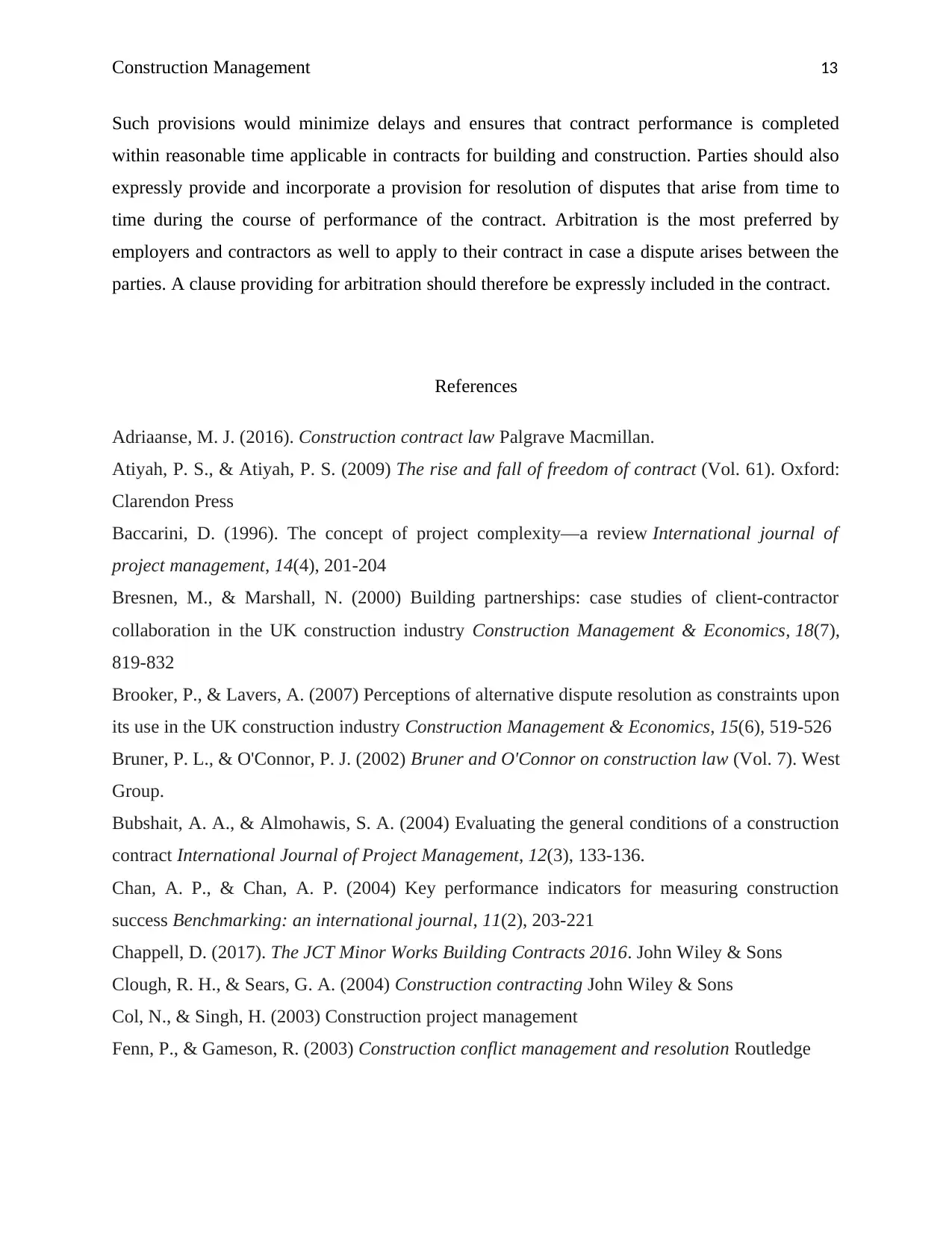
Construction Management 13
Such provisions would minimize delays and ensures that contract performance is completed
within reasonable time applicable in contracts for building and construction. Parties should also
expressly provide and incorporate a provision for resolution of disputes that arise from time to
time during the course of performance of the contract. Arbitration is the most preferred by
employers and contractors as well to apply to their contract in case a dispute arises between the
parties. A clause providing for arbitration should therefore be expressly included in the contract.
References
Adriaanse, M. J. (2016). Construction contract law Palgrave Macmillan.
Atiyah, P. S., & Atiyah, P. S. (2009) The rise and fall of freedom of contract (Vol. 61). Oxford:
Clarendon Press
Baccarini, D. (1996). The concept of project complexity—a review International journal of
project management, 14(4), 201-204
Bresnen, M., & Marshall, N. (2000) Building partnerships: case studies of client-contractor
collaboration in the UK construction industry Construction Management & Economics, 18(7),
819-832
Brooker, P., & Lavers, A. (2007) Perceptions of alternative dispute resolution as constraints upon
its use in the UK construction industry Construction Management & Economics, 15(6), 519-526
Bruner, P. L., & O'Connor, P. J. (2002) Bruner and O'Connor on construction law (Vol. 7). West
Group.
Bubshait, A. A., & Almohawis, S. A. (2004) Evaluating the general conditions of a construction
contract International Journal of Project Management, 12(3), 133-136.
Chan, A. P., & Chan, A. P. (2004) Key performance indicators for measuring construction
success Benchmarking: an international journal, 11(2), 203-221
Chappell, D. (2017). The JCT Minor Works Building Contracts 2016. John Wiley & Sons
Clough, R. H., & Sears, G. A. (2004) Construction contracting John Wiley & Sons
Col, N., & Singh, H. (2003) Construction project management
Fenn, P., & Gameson, R. (2003) Construction conflict management and resolution Routledge
Such provisions would minimize delays and ensures that contract performance is completed
within reasonable time applicable in contracts for building and construction. Parties should also
expressly provide and incorporate a provision for resolution of disputes that arise from time to
time during the course of performance of the contract. Arbitration is the most preferred by
employers and contractors as well to apply to their contract in case a dispute arises between the
parties. A clause providing for arbitration should therefore be expressly included in the contract.
References
Adriaanse, M. J. (2016). Construction contract law Palgrave Macmillan.
Atiyah, P. S., & Atiyah, P. S. (2009) The rise and fall of freedom of contract (Vol. 61). Oxford:
Clarendon Press
Baccarini, D. (1996). The concept of project complexity—a review International journal of
project management, 14(4), 201-204
Bresnen, M., & Marshall, N. (2000) Building partnerships: case studies of client-contractor
collaboration in the UK construction industry Construction Management & Economics, 18(7),
819-832
Brooker, P., & Lavers, A. (2007) Perceptions of alternative dispute resolution as constraints upon
its use in the UK construction industry Construction Management & Economics, 15(6), 519-526
Bruner, P. L., & O'Connor, P. J. (2002) Bruner and O'Connor on construction law (Vol. 7). West
Group.
Bubshait, A. A., & Almohawis, S. A. (2004) Evaluating the general conditions of a construction
contract International Journal of Project Management, 12(3), 133-136.
Chan, A. P., & Chan, A. P. (2004) Key performance indicators for measuring construction
success Benchmarking: an international journal, 11(2), 203-221
Chappell, D. (2017). The JCT Minor Works Building Contracts 2016. John Wiley & Sons
Clough, R. H., & Sears, G. A. (2004) Construction contracting John Wiley & Sons
Col, N., & Singh, H. (2003) Construction project management
Fenn, P., & Gameson, R. (2003) Construction conflict management and resolution Routledge
Paraphrase This Document
Need a fresh take? Get an instant paraphrase of this document with our AI Paraphraser
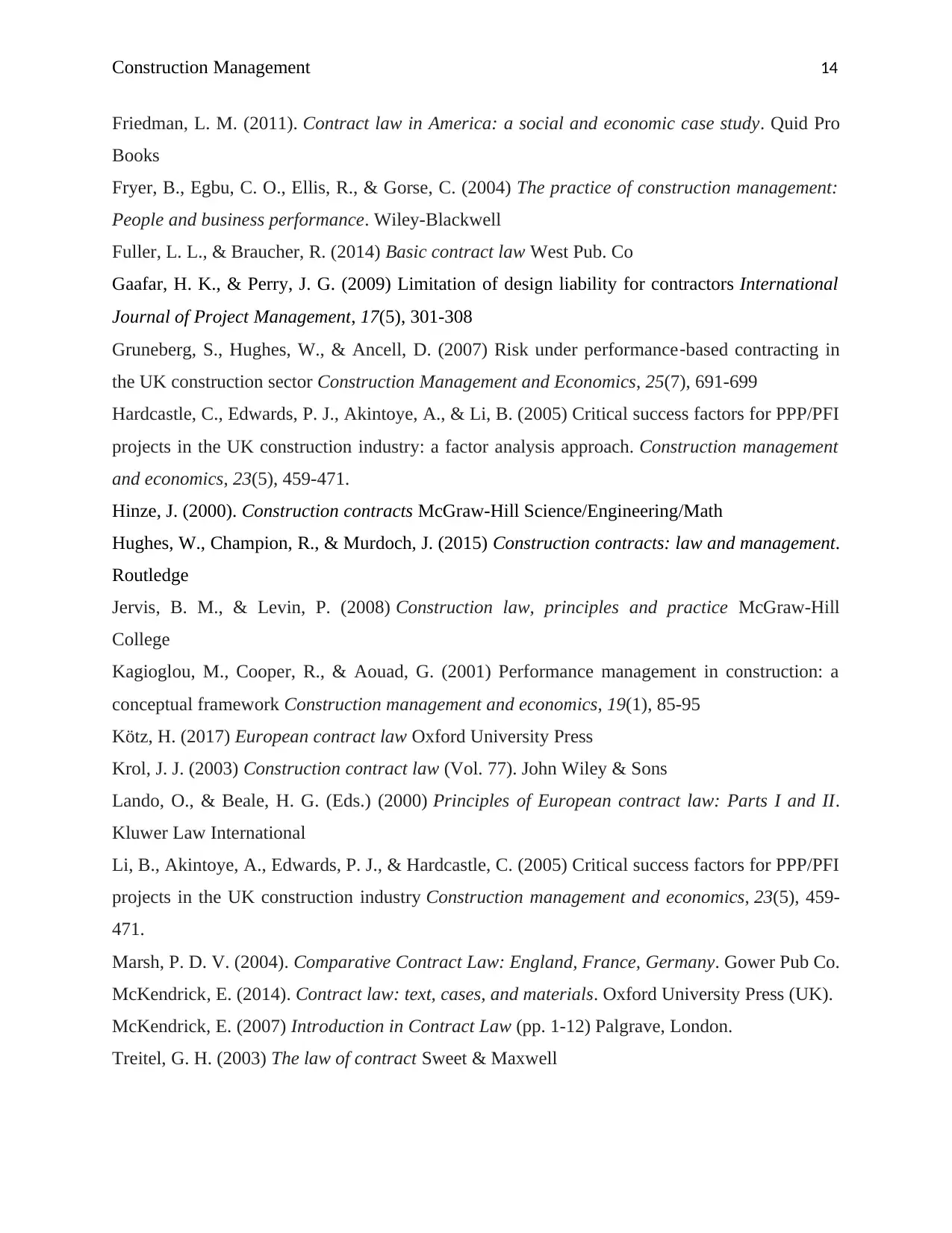
Construction Management 14
Friedman, L. M. (2011). Contract law in America: a social and economic case study. Quid Pro
Books
Fryer, B., Egbu, C. O., Ellis, R., & Gorse, C. (2004) The practice of construction management:
People and business performance. Wiley-Blackwell
Fuller, L. L., & Braucher, R. (2014) Basic contract law West Pub. Co
Gaafar, H. K., & Perry, J. G. (2009) Limitation of design liability for contractors International
Journal of Project Management, 17(5), 301-308
Gruneberg, S., Hughes, W., & Ancell, D. (2007) Risk under performance‐based contracting in
the UK construction sector Construction Management and Economics, 25(7), 691-699
Hardcastle, C., Edwards, P. J., Akintoye, A., & Li, B. (2005) Critical success factors for PPP/PFI
projects in the UK construction industry: a factor analysis approach. Construction management
and economics, 23(5), 459-471.
Hinze, J. (2000). Construction contracts McGraw-Hill Science/Engineering/Math
Hughes, W., Champion, R., & Murdoch, J. (2015) Construction contracts: law and management.
Routledge
Jervis, B. M., & Levin, P. (2008) Construction law, principles and practice McGraw-Hill
College
Kagioglou, M., Cooper, R., & Aouad, G. (2001) Performance management in construction: a
conceptual framework Construction management and economics, 19(1), 85-95
Kötz, H. (2017) European contract law Oxford University Press
Krol, J. J. (2003) Construction contract law (Vol. 77). John Wiley & Sons
Lando, O., & Beale, H. G. (Eds.) (2000) Principles of European contract law: Parts I and II.
Kluwer Law International
Li, B., Akintoye, A., Edwards, P. J., & Hardcastle, C. (2005) Critical success factors for PPP/PFI
projects in the UK construction industry Construction management and economics, 23(5), 459-
471.
Marsh, P. D. V. (2004). Comparative Contract Law: England, France, Germany. Gower Pub Co.
McKendrick, E. (2014). Contract law: text, cases, and materials. Oxford University Press (UK).
McKendrick, E. (2007) Introduction in Contract Law (pp. 1-12) Palgrave, London.
Treitel, G. H. (2003) The law of contract Sweet & Maxwell
Friedman, L. M. (2011). Contract law in America: a social and economic case study. Quid Pro
Books
Fryer, B., Egbu, C. O., Ellis, R., & Gorse, C. (2004) The practice of construction management:
People and business performance. Wiley-Blackwell
Fuller, L. L., & Braucher, R. (2014) Basic contract law West Pub. Co
Gaafar, H. K., & Perry, J. G. (2009) Limitation of design liability for contractors International
Journal of Project Management, 17(5), 301-308
Gruneberg, S., Hughes, W., & Ancell, D. (2007) Risk under performance‐based contracting in
the UK construction sector Construction Management and Economics, 25(7), 691-699
Hardcastle, C., Edwards, P. J., Akintoye, A., & Li, B. (2005) Critical success factors for PPP/PFI
projects in the UK construction industry: a factor analysis approach. Construction management
and economics, 23(5), 459-471.
Hinze, J. (2000). Construction contracts McGraw-Hill Science/Engineering/Math
Hughes, W., Champion, R., & Murdoch, J. (2015) Construction contracts: law and management.
Routledge
Jervis, B. M., & Levin, P. (2008) Construction law, principles and practice McGraw-Hill
College
Kagioglou, M., Cooper, R., & Aouad, G. (2001) Performance management in construction: a
conceptual framework Construction management and economics, 19(1), 85-95
Kötz, H. (2017) European contract law Oxford University Press
Krol, J. J. (2003) Construction contract law (Vol. 77). John Wiley & Sons
Lando, O., & Beale, H. G. (Eds.) (2000) Principles of European contract law: Parts I and II.
Kluwer Law International
Li, B., Akintoye, A., Edwards, P. J., & Hardcastle, C. (2005) Critical success factors for PPP/PFI
projects in the UK construction industry Construction management and economics, 23(5), 459-
471.
Marsh, P. D. V. (2004). Comparative Contract Law: England, France, Germany. Gower Pub Co.
McKendrick, E. (2014). Contract law: text, cases, and materials. Oxford University Press (UK).
McKendrick, E. (2007) Introduction in Contract Law (pp. 1-12) Palgrave, London.
Treitel, G. H. (2003) The law of contract Sweet & Maxwell

Construction Management 15
Poage, W. S. (2000). The building professional's guide to contract documents RS Means
Company.
Wood, G. D., & Ellis, R. C. (2005) Main contractor experiences of partnering relationships on
UK construction projects Construction Management and Economics, 23(3), 317-325
Poage, W. S. (2000). The building professional's guide to contract documents RS Means
Company.
Wood, G. D., & Ellis, R. C. (2005) Main contractor experiences of partnering relationships on
UK construction projects Construction Management and Economics, 23(3), 317-325
1 out of 15
Related Documents
Your All-in-One AI-Powered Toolkit for Academic Success.
+13062052269
info@desklib.com
Available 24*7 on WhatsApp / Email
![[object Object]](/_next/static/media/star-bottom.7253800d.svg)
Unlock your academic potential
© 2024 | Zucol Services PVT LTD | All rights reserved.




